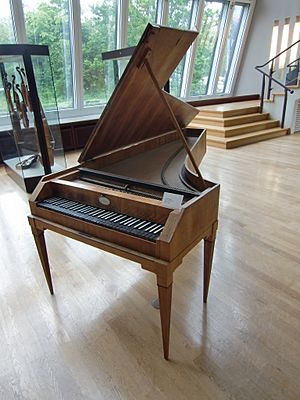Minuet in G (Beethoven) facts for kids
The Minuet in G, WoO 10, No. 2, is a famous piece of music for the piano. It was written by the well-known composer Ludwig van Beethoven. This piece was first created for a full orchestra. However, that orchestral version was lost a long time ago. Today, we only have a special version of it made for the piano. It's a very popular piece, especially for people who are just starting to learn the piano.
Understanding the Music
This piece of music is built in a special way called ternary form. You might also hear it called ABA form. This means the music has three main parts. The first part (A) and the third part (A) are exactly the same. The middle part (B) is different. The B section often sounds very different from the A section, creating a nice contrast.
The speed of the Minuet in G is marked as Moderato. This means it should be played at a medium speed, not too fast or too slow. The music also has a meter of 3/4. This means there are three quarter-note beats in each measure. Think of it like a waltz, with a steady "one-two-three" feel.
The A Section: Main Melody
The first part, the A section, is made up of two smaller parts, each 8 measures long. This makes a total of 16 measures. The main tune in this section has a special rhythm. It uses a repeating pattern of a dotted eighth note followed by a sixteenth note. This pattern is played smoothly, which musicians call legato.
The first 8 measures are played and then repeated. This part starts in the main key of G major. Then, it gently changes to the key of D major, which is called the dominant key. The next 8 measures are also played and repeated. This part starts in D major and then changes back to the main key of G major. So, the whole A section begins and ends in G major, with short visits to D major.
In the A section, the right hand on the piano mostly plays two notes at once, like thirds and sixths. The left hand plays simpler, steady quarter notes.
The B Section: The Trio
The B section is also known as the Trio. Just like the A section, it has two parts, each 8 measures long, for a total of 16 measures. It also starts in G major and changes to D major by the end of the first 8 measures. This part is repeated. The second 8 measures start in D major and then return to G major. These 8 measures are also repeated.
The B section sounds different because the right hand plays a continuous flow of eighth notes. This creates a smooth, flowing sound. The left hand mostly plays quarter notes. However, at the beginning of the second 8-measure part, the left hand briefly joins the right hand in playing eighth notes. As this section finishes, the left hand goes back to playing quarter notes.
Once the B section is finished, and all its repeats are played, the music returns to the A section. This final A section is usually played without repeating its parts.


